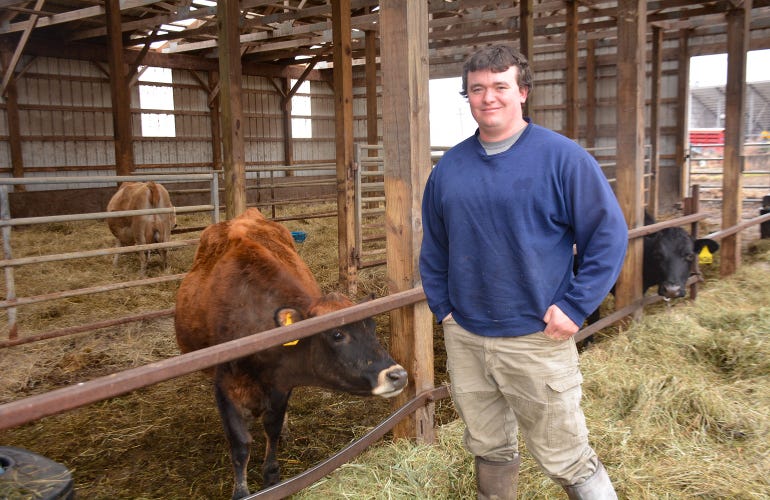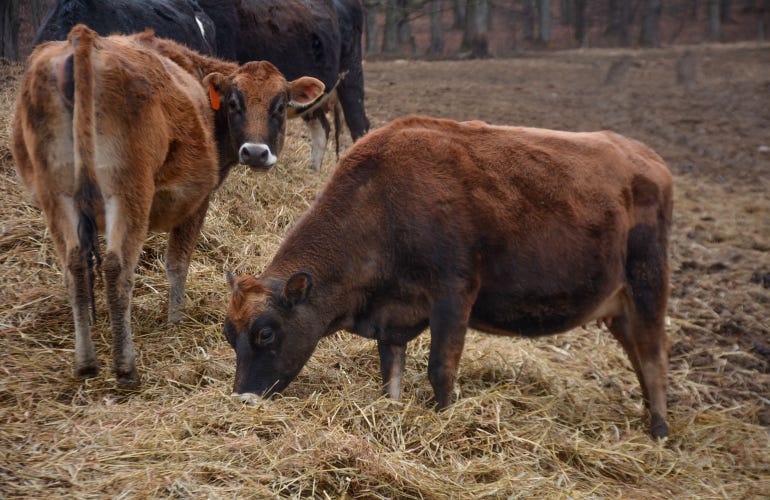It’s always been dairy farming or bust for Ryan Murray.
He dropped out of college in the late 2000s and went to live at home. College wasn’t Murray’s thing, but his parents wanted him to have a plan for the future.
“My mom said, ‘Well, you can’t just … stay here and do nothing,’” he says. So, he bought a few heifers and started getting ready for a transition to organic.
In spring 2013, he started his organic dairy operation with just 35 cows.
Being a seasonal dairy, he says, provides a “weird economy of scale.” He does all his calving at once starting in April. But being seasonal is key because he is mainly a grazing operation. He doesn’t have much of his own equipment, so he can’t afford to make too much feed for the entire year.
Plus, the seasonality of the herd — no milking in winter as he dries the cows off for two to three months — allows him to time their grazing for the spring flush, when he can get the highest quality forage out of his pasture.
Slow expansion
Murray’s first expansion around 2013 was building the herd to 45 cows. It was around that time that he met and later got engaged to his current wife, Annie.
“We decided that if we were going to try to support two of us, that we should start slowly expanding the herd so we could accommodate two people,” he says.
 SEASONAL FIT: Murray runs a seasonal dairy, a system that he says allows him to take advantage of the highest forage in the spring and cut down on feed costs in winter, when the cows are dry.
SEASONAL FIT: Murray runs a seasonal dairy, a system that he says allows him to take advantage of the highest forage in the spring and cut down on feed costs in winter, when the cows are dry.

Another expansion was done in 2017 bringing them up to 65 cows, and another expansion in 2018 raised the herd to 80 cows. This year, the 28 year old rancher is calving 100 cows.
The couple also recently welcomed their first child, Charles, who is 5 months old.
Learning from the kiwis
Murray says that he models his organic dairy after the New Zealand dairy model, where 95% of farms are seasonal and most practice intensive grazing management. When winter comes along the cows are dried off, reducing the need for high-quality feed.
“It’s a really cheap and effective way to get a lot of good, really high-quality dry matter into your cows very cheaply,” he says.
Murray doesn’t push his cows. The Jersey and Jersey-crosses only produce between 8,000 and 9,000 pounds per head. Somatic cell count fluctuates between 100,000 and 180,000. But Murray also spends a lot less on inputs.
It’s not a perfect system. One of the challenges of continuous grazing, he says, is having enough continuous land acreage close to the milking facility. Luckily, he is back on the farm he grew up on. He and his parents did a land swap a few years ago where his parents took over his former farm and he went to farm his parent’s former operation. Ryan leases 154 grazable acres from his parents, along with an additional 100 acres that are not adjacent to the milking parlor.
Planning for the future
Murray gets $36 per cwt for his milk. He’s not complaining, especially considering how COVID-19 has helped to upend the conventional dairy market, sending prices tumbling and forcing many farmers in the Northeast to dump milk.
But the organic dairy price has come down significantly. He saw prices as high as $50 per cwt in 2016 — when components were at their highest levels and he also got beginning producer incentives. That year he averaged $40 per cwt.
Murray’s base price contract with Upstate Niagara Cooperative is set each year in November for the following year. Since organic relies mostly on retail sales and not food service, he says that he’s not seeing any impacts on his operation from COVID-19, at least not yet.
Still, he has a plan for the future.
“The newest thing in the organic market is 100% forage and grass-fed cows. We’re actually moving in that direction to have our herd prepared for that,” he says.
 ALL JERSEYS: Murray is calving 100 Jersey and Jersey-crosses this spring. He initially started out with 35 cows in 2013 and has slowly grown the operation to accommodate his small family.
ALL JERSEYS: Murray is calving 100 Jersey and Jersey-crosses this spring. He initially started out with 35 cows in 2013 and has slowly grown the operation to accommodate his small family.

He’s breeding cows with bulls that have an older-style phenotype where they can make it on just forage. His goal is to have cows that produce about the same as his current herd, between 8,000 and 9,000 pounds a head.
As the price for organic is fetching the same as organic grass-fed, he doesn’t see the financial advantage to switching over just yet. But the writing is on the wall, he says, and he sees switching over within the next five years.
“I’m not really sure we can compete with those really big, really well-managed farms,” he says. “We’ve got to try something different if we’re going to stick it out in this business for the rest of our working careers, which is our goal.”
Read more about:
PodcastsAbout the Author(s)
You May Also Like






